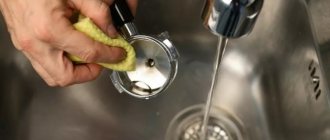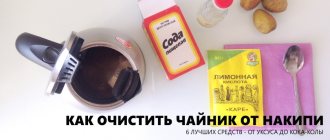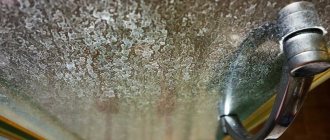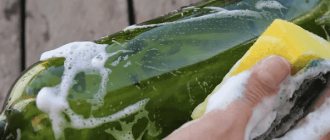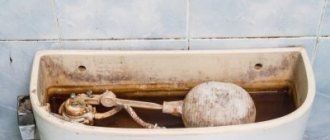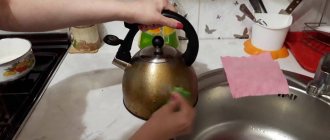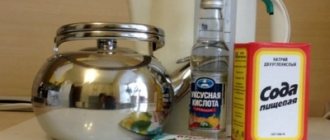Not everyone knows how to clean a teapot from tea deposits at home. Now there are dishwashers that do an excellent job of removing dirt. However, it is not recommended to clean the kettle manually, and it does not take much time. How to clean a teapot from tea deposits? Citric acid, salt and even Coca-Cola perfectly cleanse all impurities. All ingenious recipes are accessible and easy to use.
Lemon acid
A universal and safe cleanser. Citric acid cleanses any plaque well and fights unpleasant odors:
- Place 1 or 2 (depending on the degree of contamination) bags of citric acid on the bottom of the kettle.
- Pour boiling water so that the water completely covers all contaminated parts of the teapot.
- Leave for at least an hour or until the water has cooled completely.
- If the plaque is old, you can leave the solution overnight.
- After draining the water, rinse the kettle with boiling water several times. Rub particularly dirty areas with a sponge.
- Rinse with clean water and set to dry.
How to clean the outside of a kettle
There are many simple and effective tools and methods to combat persistent pollution. Let's look at each of them in more detail.
Soda
This substance is ideal for cleaning all surfaces of kitchen utensils. Baking soda is used on cups, plates, pans, pots and appliances. This product is perfect for cleaning stainless steel from the following types of contaminants:
- traces of rust;
- oil stains;
- scale;
- fat deposits.
1 way
We wipe the kettle from dust from the outside and place it on the table. Apply baking soda powder to a sponge or damp cloth and begin wiping the surface. After 10-15 minutes, the active substance will be absorbed into the metal and destroy stubborn stains. After this, the powder is washed off with clean water. Next, heat the water in the kettle until it boils and clean the inside of the bowl. Be careful when carrying out such work; hot metal can cause skin burns.
The main disadvantage of soda is that it contains abrasive particles; exposure to the powder can cause scratches on the body of the device.
Method 2
Pour water into a large saucepan or other metal container and dissolve soda at the rate of 5 grams of the substance per liter of liquid. We place the kettle and turn on the fire on the stove (if part of the device does not come into contact with the device, it must be turned over after a while). Boiling is carried out for 25-30 minutes, after which the liquid should cool to room temperature. Take a damp cloth and wipe off all plaque and other dirt on the surface of the household appliance.
3 way
Now we know how to clean the outside of a stainless steel kettle using soda. To enhance the effect, this substance is combined with vinegar. 20 grams of soda and the same amount of vinegar are poured into a saucepan with water. These components are thoroughly mixed, after which a kettle is placed in the container and the pan is placed on the stove, the gas is turned on or electricity is supplied.
Tablets for cleaning dentures
These tablets are used to clean dentures from plaque and food debris, so they can also easily cope with tea plaque:
- Place 1-2 tablets on the bottom of the kettle and fill with boiling water (it is better to find out the exact ratio of the number of tablets and water by reading the instructions).
- Since the cleaning process will create a lot of foam, place the kettle in the sink or on a tray.
- After a few hours (if it’s heavily soiled, it’s better to leave it until the morning), drain the water, scrub the walls with a sponge and rinse well with water.
Bleach for difficult cases
If natural products are unable to cope with strong tea stains, you can wash the teapot in bleach.
It is necessary to dissolve 5 tbsp in 1 liter of warm water. l. Whiten and soak the teapot in this solution overnight. In the morning, all that remains is to run a sponge over the surface of the dishes and rinse them very thoroughly after exposure to chemicals.
Simple and affordable products will help keep your kitchen utensils perfectly clean. The teapot should always shine clean, and then drinking tea will be a real pleasure.
Vinegar
Vinegar works well on old stains and unpleasant odors. When working with vinegar, be sure to wear gloves.
Pour table vinegar in a volume of no more than a quarter of the total volume of the teapot into the bottom of the teapot. Add hot water (not boiling water) on top. Cover with a lid and leave for at least 4-5 hours. Then drain the vinegar solution and rinse the kettle with water. You can additionally use dishwashing detergent. Leave it in the fresh air. After complete drying, there will be no trace of the smell of vinegar left.
Why is it necessary to clean the teapot?
The strainer inside the teapot becomes very clogged with the coloring pigment - tannin, which is contained in tea, so it is especially noticeable how the tea leaves become cloudy in a glass teapot. Even thorough rinsing after each brew does little to help remove plaque. Therefore, brown marks remain on the inner walls and on the spout of the kettle. Over time, the strainer stops allowing tea leaves to pass through and requires careful cleaning, because the holes in it become very clogged.
Important! If your item is quite old and you don't really like the design, consider buying a new one. Perhaps it will give you more pleasure.
Read about how to choose a good quality teapot.
Of course, you can use an alternative method - use disposable tea bags for brewing. However, the quality of such a drink is not high, since production waste is usually used to make such teas, rather than high-quality leaves of tea trees.
Baking soda
Baking soda is a universal cleaning and disinfectant for dishes. It cleans not only due to its chemical composition, but also due to its fine-grained structure, mechanically removing the top layer of dirt:
- Mix a small amount of baking soda with water to form a thick paste.
- Apply the paste to a sponge and lightly scrub all dirty surfaces of the kettle. Proceed carefully, without forceful pressure.
- Next, you can fill the kettle with hot water, or you can simply leave the soda paste on the walls for a while.
- Then rinse the teapot well and dry.
Use of folk remedies
Using the following folk remedies, you can remove tea stains quickly and without harm to the enamel:
- Apply a small amount of baking soda to the brush and brush your teeth;
- crush a few tablets of activated carbon and brush your teeth;
- rinse your mouth with a solution of hydrogen peroxide and water (half a glass of warm water and 25 drops of peroxide). Use as a rinse after brushing your teeth. Do not abuse this method so as not to harm the enamel;
- After traditional brushing, add a few drops of tea tree oil to the brush and brush your teeth again;
- rub the surface of the dentition with the inside of a banana skin;
- Mix half a teaspoon of turmeric with a few drops of water and brush your teeth with this paste.
It is often not recommended to use traditional methods, so as not to damage the tooth enamel, it is better to consult a specialist.
Coca Cola
Coca-Cola and similar drinks contain phosphoric acid, which can remove any type of plaque from many surfaces in a short time.
If the stains are light: pour Coca-Cola into the kettle and leave for several hours. Then drain and evaluate the result. The procedure can be repeated if necessary.
If there is a strong coating: heat the Coca-Cola without boiling and pour it into the kettle. Then proceed as in the first point.
After clearing the kettle of deposits, rinse it with water and set it to dry.
Cleaning the sieve
When deciding how to clean a metal sieve, you can use one of the following effective methods.
Ammonia
An effective way to clean dishes and their components from traces of tea is ammonia diluted in cold water. It should be used as follows:
- Add a couple of teaspoons of ammonia to a glass half filled with clean water.
- Stir the solution thoroughly.
- Leave dirty dishes in it.
- Let the utensils soak in water.
- Clean away any remaining residue in hard-to-reach places.
Important! After cleaning, the teapot and sieve should be thoroughly rinsed in clean cold water.
Kitchen salt
One of the simplest, yet effective ways to clean a sieve is to use a concentrated saline solution:
- Make a saturated solution from kitchen salt.
- Dip a contaminated strainer into it.
- Wait half an hour - during this time the salt will remove dirt from small holes.
- Remove any remaining plaque with a sponge.
Important! Carrying out a periodic cleaning procedure will allow you to keep the teapot clean without significant expenditure of time and effort.
Dishwasher
A modern way to clean a teapot is to wash it in the dishwasher. This method is very effective, but its use is not always rational. Focus on the material from which the teapot is made. And remember that sometimes cleaning the strainer in the dishwasher is contraindicated, while a saline solution will definitely not harm anything.
Varieties
Nowadays, a large number of types of strainers have appeared. They all differ in material, shape, color.
The main materials used for the purpose of producing tea infuser are stainless steel and silver. However, they have a competitor - silicone, which has a number of valuable properties:
- The shape of the silicone product does not change over time.
- This material is heat-resistant.
- A high-quality product does not harm the human body.
- Silicone is very flexible, so it can be molded into different shapes.
A silver tea accessory can act as a gift for a loved one. This metal has a bactericidal effect, which increases the benefits of tea. The silver sieve also does not change its properties over time.
Tea sieves are further divided into groups: open and closed. The first ones are a concave product with a handle, which is convenient to hold on to when pouring tea from a kettle. This is the simplest and most common type. Closed strainers-tongs with a clamp, which can have a simple or unusual shape, are also popular.
You can also brew tea leaves directly in a mug using a small ball-shaped strainer (ball tea strainer). It consists of two parts: the ball itself, where the tea leaves are poured, and a chain that you can hold on to.
A spoon-strainer is also sold. The principle of its use: the required amount of tea leaves is placed in a spoon, then the product is placed in boiling water, the drink is infused and the sieve is removed. There are mugs/thermoses with strainers for brewing.
There are also strainer presses. They are simple to use: take tea, pour it into a sieve, close it, then lower the product into boiling water and after a while press a special button.
Home Remedies
Nowadays, you can also use special devices at home that can help eliminate tea stains:
- Using an electric toothbrush. With its help you can quickly remove fresh plaque.
- Using special whitening strips. Glue the strip to the surface of the dentition. Wait half an hour and then remove. Use such devices daily for two weeks.
- Using a special whitening gel. This is an affordable and safe remedy. Within two weeks the first results will be visible.
- Mouthguards. In appearance they resemble false jaws. They are put on the teeth according to the instructions. Suitable for removing even old plaque.
- Sticks. Suitable for removing fresh plaque.
- Special pencil for lightening. Suitable for removing fresh stains.
Using simple but effective remedies, you can get rid of stains on enamel that remain after drinking excessively strong black tea.
. Or contact your dentist for professional whitening.
Dear readers! Subscribe to our channel “ TvoyZubnoy ” and you will not miss our new publications. Share this information on social networks and like it - Our team will be pleased to see that our efforts are appreciated by you.
Consultation with a doctor on all issues is required.
How to choose
To ensure that your first purchase of a tea strainer does not disappoint you, you need to adhere to some rules. First you need to choose the material and manufacturer. When choosing a silicone strainer, it is extremely important to choose a reliable manufacturer who does not skimp on the quality of the material.
The presence of a foreign odor indicates the low quality of the silicone tea accessory.
While still in the store, it is important to determine how convenient it is to use the purchased product. For example, a sieve made of two parts needs to be opened and closed a couple of times, while determining the ease of performing the action. Any accessory should always have a chain, handle, etc. for ease of lowering and removing it from a hot drink. This allows you to avoid burning your hands and using a spoon.
It is also important to determine how convenient the sieve is when pouring ingredients into it. Most strainers have a narrow shape, and therefore some of the tea leaves sometimes end up on the table. An original tea accessory can be a small gift for family and friends. Different shapes and colors of sieves can decorate tea drinking and lift your spirits.

